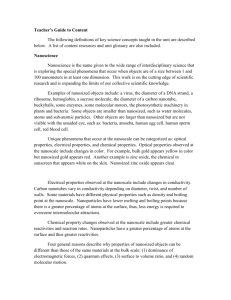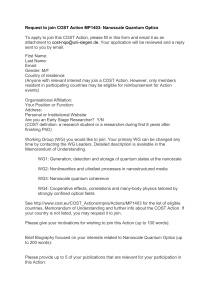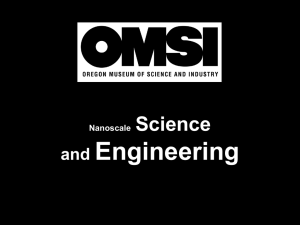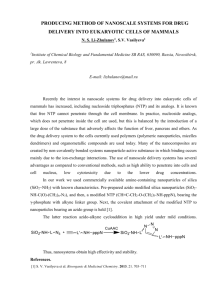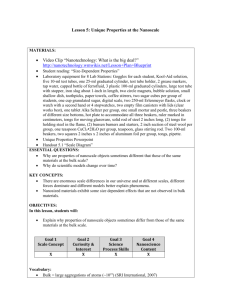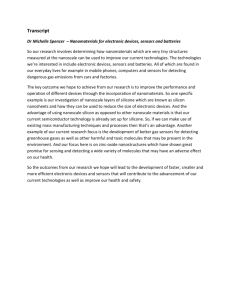Rationale: Overarching Concept The overarching concept in this unit
advertisement
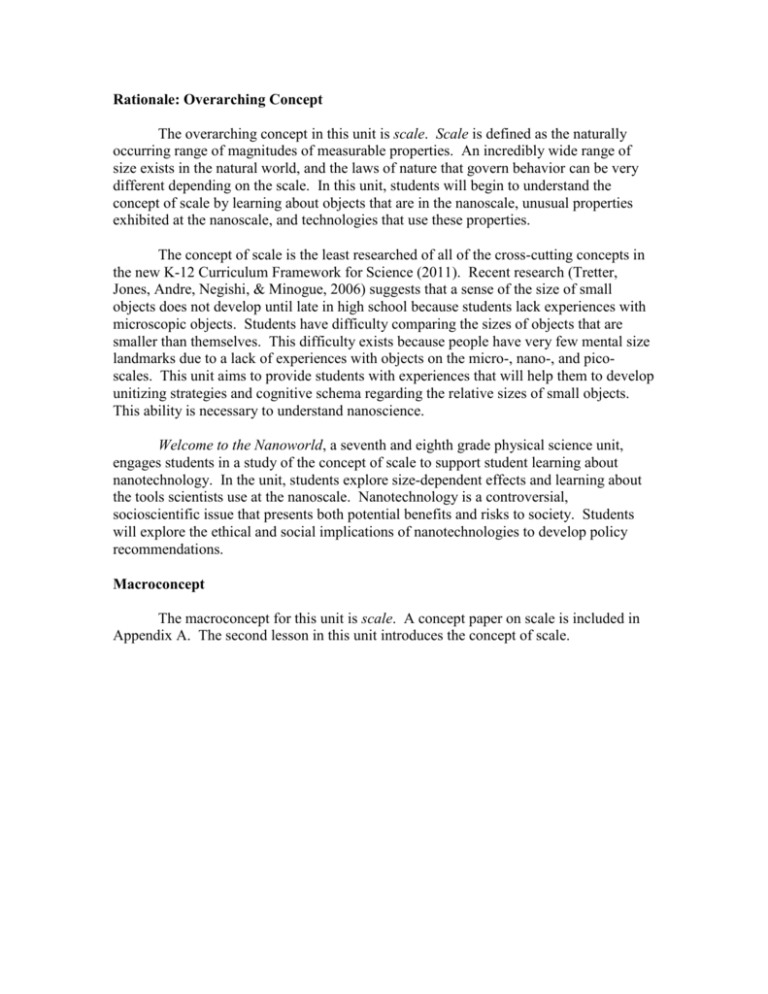
Rationale: Overarching Concept The overarching concept in this unit is scale. Scale is defined as the naturally occurring range of magnitudes of measurable properties. An incredibly wide range of size exists in the natural world, and the laws of nature that govern behavior can be very different depending on the scale. In this unit, students will begin to understand the concept of scale by learning about objects that are in the nanoscale, unusual properties exhibited at the nanoscale, and technologies that use these properties. The concept of scale is the least researched of all of the cross-cutting concepts in the new K-12 Curriculum Framework for Science (2011). Recent research (Tretter, Jones, Andre, Negishi, & Minogue, 2006) suggests that a sense of the size of small objects does not develop until late in high school because students lack experiences with microscopic objects. Students have difficulty comparing the sizes of objects that are smaller than themselves. This difficulty exists because people have very few mental size landmarks due to a lack of experiences with objects on the micro-, nano-, and picoscales. This unit aims to provide students with experiences that will help them to develop unitizing strategies and cognitive schema regarding the relative sizes of small objects. This ability is necessary to understand nanoscience. Welcome to the Nanoworld, a seventh and eighth grade physical science unit, engages students in a study of the concept of scale to support student learning about nanotechnology. In the unit, students explore size-dependent effects and learning about the tools scientists use at the nanoscale. Nanotechnology is a controversial, socioscientific issue that presents both potential benefits and risks to society. Students will explore the ethical and social implications of nanotechnologies to develop policy recommendations. Macroconcept The macroconcept for this unit is scale. A concept paper on scale is included in Appendix A. The second lesson in this unit introduces the concept of scale. Key Science Concepts By the end of this unit, students will understand that: The study of unique phenomena at the nanoscale could vastly change our understanding of matter and lead to new questions and answers in many areas, including health care, the environment, and technology. There are enormous scale differences in our universe, and at different scales, different forces dominate and different models better explain phenomena. Nanosized materials exhibit some size-dependent effects that re not observed in bulk materials. New tools for observing and manipulating matter increase our abilities to investigate and innovate. Teacher’s Guide to Content The following definitions of key science concepts taught in the unit are described below. A list of content resources and unit glossary are also included. Nanoscience Nanoscience is the name given to the wide range of interdisciplinary science that is exploring the special phenomena that occur when objects are of a size between 1 and 100 nanometers in at least one dimension. This work is on the cutting edge of scientific research and is expanding the limits of our collective scientific knowledge. Examples of nanosized objects include: a virus, the diameter of a DNA strand, a ribosome, hemoglobin, a sucrose molecule, the diameter of a carbon nanotube, buckyballs, some enzymes, some molecular motors, the photosynthetic machinery in plants and bacteria. Some objects are smaller than nanosized, such as water molecules, atoms and sub-atomic particles. Other objects are larger than nanosized but are not visible with the unaided eye, such as: bacteria, amoeba, human egg cell, human sperm cell, red blood cell. Unique phenomena that occur at the nanoscale can be categorized as: optical properties, electrical properties, and chemical properties. Optical properties observed at the nanoscale include changes in color. For example, bulk gold appears yellow in color but nanosized gold appears red. Another example is zinc oxide, the chemical in sunscreen that appears white on the skin. Nanosized zinc oxide appears clear. Electrical properties observed at the nanoscale include changes in conductivity. Carbon nanotubes vary in conductivity depending on diameter, twist, and number of walls. Some materials have different physical properties such as density and boiling point at the nanoscale. Nanoparticles have lower melting and boiling points because there is a greater percentage of atoms at the surface, thus, less energy is required to overcome intermolecular attractions. Chemical property changes observed at the nanoscale include greater chemical reactivities and reaction rates. Nanoparticles have a greater percentage of atoms at the surface and thus greater reactivities. Four general reasons describe why properties of nanosized objects can be different than those of the same materials at the bulk scale: (1) dominance of electromagnetic forces, (2) quantum effects, (3) surface to volume ratio, and (4) random molecular motion. Electromagnetic forces dominate at the nanoscale because the gravitational force depends on mass and is weak between nanosized particles. The electromagnetic force depends on charge and can be very strong even when particles are small. At the nanoscale, classic mechanical models that worked at the macroscale no longer work. At the nanoscale, probability concepts explain phenomena such as quantum tunneling, where an electron can pass through a barrier. As surface to volume ratio increases, a greater amount of the substance is in contact with the surrounding material which increases reaction rates. Random molecular motion (the vibration, rotation and motion of molecules) occurs in all substances, but at the nanoscale this motion is as large as the size of the particles and becomes an important influence on how nanoparticles behave. Visible light cannot be used to see objects at the nanoscale because the objects we want to see are smaller than the wavelength of light. The tools used to “see” objects at the nanoscale use other kinds of interactions, such as electrical and magnetic forces, to create a representation of the object. These technology tools include the atomic force microscope and the scanning tunneling microscope. The atomic force microscope uses a tiny tip that responds to the electromagnetic forces between the atoms on the surface of the object and the tip. The scanning tunneling microscope uses electrical current to create a topographical image of the object. Existing applications of nanotechnology include: Stain resistant clothes – fine fibers, or nanowhiskers act like peach fuzz to create a cushion of air around the fabric so that liquids bead up and roll off. Nano solar cells – a new kind of solar cell that uses nanoparticles of TiO2 coated with dye molecules to capture the energy of visible light and convert it into electricity. These cells are less expensive to produce. Clear sunscreen – ZnO and TiO2 nanoparticles provide the same sun protection as their normal sized counterparts but are so small that they do not scatter visible light and appear clear on the skin. Building smaller devices and chips – a technique called nanolithography allows microchips to be made much smaller. Health monitoring – nano-devices are being developed to keep track of daily changes in patients’ glucose and cholesterol levels. Potential applications include: Paint that cleans the air Paint on solar cells Drug delivery systems Water treatment Clean energy Detecting disease with quantum dots Nanotechnology holds the promise of great benefits to society, but at what cost? The toxicity of nanoparticles is relatively unknown and there are ethical considerations for the introduction of nanosized montinoring devices. Students will explore the risks and benefits of nanotechnology using current sources of news and scientific literature.
